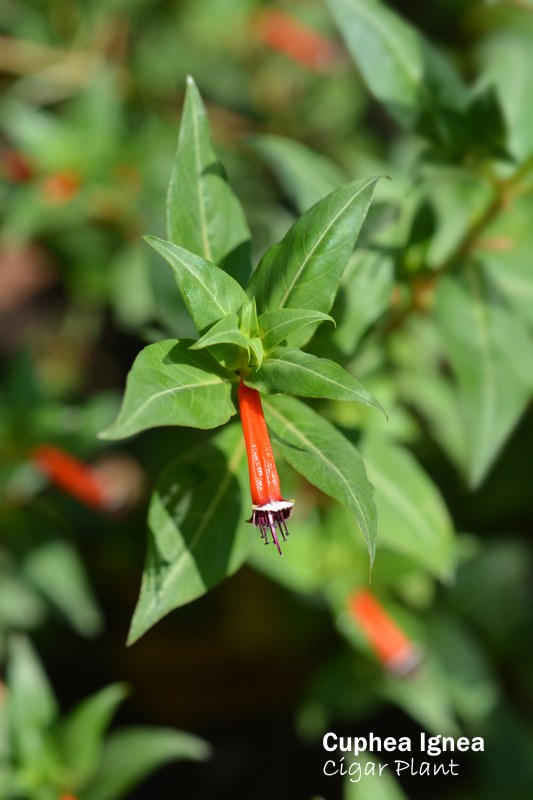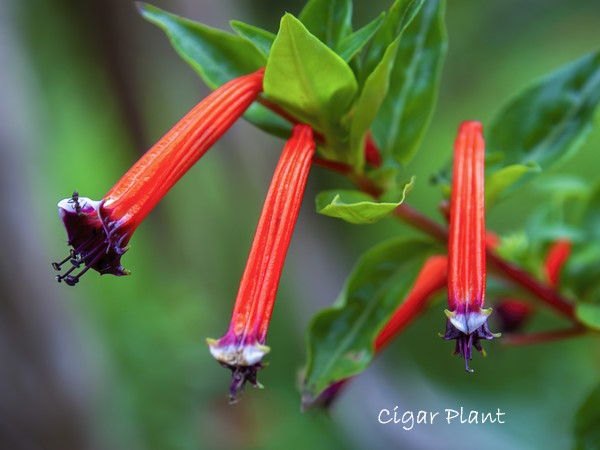Cigar Plant
Cigar plant features tubular, orange-red flowers rimmed with white and purple, giving the flowers the look of a burning cigar with ashes at the tip.
Known botanically as Cuphea ignea, this flowering shrub is easy to grow and makes an eye-catching houseplant. Give it lots of sunlight and you'll enjoy plenty of flowers for months on end.
 Close-up of the cigar flower. Give this sun-lover what it wants and it'll reward you with lots of blooms. Photo © Iva Villi
Close-up of the cigar flower. Give this sun-lover what it wants and it'll reward you with lots of blooms. Photo © Iva VilliGet to Know Cigar Plant
Its unusual blooms are simply captivating, making this small shrub fun to grow as a houseplant. Give it plenty of sunlight and you can expect flowers to appear in abundance from early summer to late fall. They're about 1 in (2.5 cm) long, growing singly from the axils of the leaves.
This evergreen sub-shrub is fast-growing, reaching its mature height in a year. Narrow leaves are 2 in (5 cm) long and densely cover the woody stems. You'll want to prune it quite a bit to keep it small and bushy, when growing Cigar Plant indoors.
Cuphea ignea goes by a few common names and resembles other plants. Look for the botanical name to be sure you're getting this plant. Some other common names include Cigar Flower and Mexican Cigar Plant.
More Cuphea species exit, but Cuphea ignea is the only one I know that grows well indoors. Some cultivars are available with pink or white flowers and variegated leaves.
Cigar Plant Problems, Solutions and Answers
Repot in spring when this shrubby plant gets crowded. Take care not to over-pot; move it up to a container 1- to 2-inches (2.5 to 5 cm) larger. Why? Cigar plants bloom best when their roots are a little snug. Use a pot with drainage holes to prevent overwatering -- stems will rot at the base if the soil gets too soggy. A terra cotta pot is ideal, because it "breathes" allowing the soil to dry out faster.
Dry, crunchy leaves that fall off is often caused by cold drafts or dry air. Keep cigar plant away from windows, doors, and heat/AC vents. If indoor air is dry, take a look at "Humidity" tips below for easy solutions.
Prune it back. Cut the stems back by half in late winter to encourage new growth and more flower buds. Make the cut just after a node -- the place where a leaf is attached to a stem. Use sharp pruners to avoid tearing the stems. Regular pinching and pruning will help this small shrub keep its rounded shape. Unfortunately, this vigorous grower will become straggly over time; plan on replacing Cuphea ignea after a couple years or so.
Something bugging your plant? Aphids tend to attack new growth, which cigar plant has in abundance. Also watch for spider mites that are attracted to dry conditions in the winter months. Isolate any infested houseplant and treat it right away. Boosting the humidity around your houseplant will help to prevent an infestation.
Wondering how to overwinter cigar plant? Shorter daylight hours will cause the growth to slow down, but keep this sun-lover near a window where it'll get the most sunlight. If you don't have window space available for it, a grow light will do. Water less during the winter months, keeping the potting mix lightly moist. Stop fertilizing till spring, when new growth begins. In late winter, you can prune it back (see pruning tips above).
 It's easy to see how Cigar Plant gets its name. Photo credit © Mauricio Acosta
It's easy to see how Cigar Plant gets its name. Photo credit © Mauricio AcostaHow to Grow Cigar Plant
Origin: Mexico
Height: 2 ft (60 cm)
Light: Bright light to full sun. Moving your cigar plant outdoors for the spring and summer will give it the sunlight it needs to stay healthy and produce the most flowers. Bright light will make the leaves appear brighter and the leaf tips to turn an attractive reddish-purple.
Water: Spring through fall, water thoroughly. Allow the soil to dry slightly between waterings, but don't allow it to dry out completely. Keep the soil slightly drier in winter when growth is slower.
Humidity: Average indoor (around 45% relative humidity). Indoor air can become extremely dry during the winter months. It's a good idea to use a humidity monitor, rather than guess. If indoor humidity drops, use a cool-mist room humidifier or set the pot on a wet pebble tray.
Temperature: Average room 65-75°F/18-24°C. If you move your cigar plant outdoors for the summer, don't worry -- it can take the heat. It won't, however, tolerate temperatures below 50°F/10°C.
Soil: All-purpose, good-quality potting mix
Fertilizer: Feed every 2 weeks spring through fall with a balanced, water-soluble fertilizer diluted by half.
Propagation: Making more cigar plants is easy. Take 3 in (7.5 cm) stem tip cuttings in summer and root them in moist perlite. Once rooted, transplant them in separate pots with fresh potting mix. Sow seeds in early spring, keeping them warm and moist.


